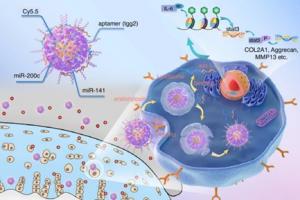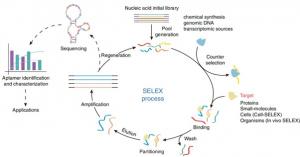Nucleic Acid Aptamers for Advancing Targeted Therapies for Bone Diseases
Researchers examine the benefits of employing aptamers in targeted therapies for bone tissue regeneration
SICHUAN, SICHUAN, CHINA, August 26, 2025 /EINPresswire.com/ -- Nucleic acid aptamers have attained significant prominence in diagnostics, therapeutics, and medical research owing to their affinity towards multiple molecular targets. Researchers have delved into the realm of aptamer research and their potential clinical applications, encompassing their prospects for treating a diverse array of orthopedic diseases. Although they can serve as an efficient and safe means for therapeutic delivery, further investigations regarding aptamer screening and production cost reduction are requisite.Precision medicine is of substantial significance in contemporary medicine as it enables targeted interventions for a variety of diseases with a relatively low probability of side - effects. Nucleic acid aptamers, which are short, single-stranded DNA or RNA molecules capable of binding to specific target molecules with high affinity and specificity, are emerging as a novel tool in precision medicine. This is due to their notable advantages over traditional methods in the fields of diagnostics, therapeutics, and research. In recent years, nucleic acid aptamers have shown considerable potential in the management of orthopedic diseases.
In this vein, in a recent Bone Research article published on July 24, 2025, researchers from China led by Dr. Huan Liu from Southwest Medical University and Dr. Weihu Yang from Chongqing University, comprehensively explored the molecular mechanisms and biological roles underlying the use of aptamers for orthopedic treatments. The researchers found that aptamers represent a transformative treatment approach for a wide variety of orthopedic conditions, including osteoporosis, osteosarcoma, and osteoarthritis.
“Aptamers are oligonucleotide fragments derived from the systematic evolution of ligands by exponential enrichment (SELEX) technology, characterized by their high affinity and specificity towards target molecules. They can be either DNA or RNA sequences, with some studies also exploring nucleic acid analogs and peptides,” as explained in the review. It further notes that “Aptamers possess notable advantages, including considerable biological stability, potential for universal chemical modification, low immunogenicity, and rapid tissue penetration.”
Aptamers can recognize and bind to a wide range of therapeutic targets such as proteins, RNA, DNA, and small molecules. As a result, aptamers can be designed to modulate key molecular pathways involved in bone repair, such as parathyroid hormone (PTH), bone morphogenetic proteins (BMPs), and the Wnt/β-catenin signaling pathway, thereby expediting recovery. In their article, the authors revealed how aptamers can advance the standard of care for fractures, alveolar bone, articular cartilage, and osteochondral tissue, as well as osteoporosis and several types of bone cancers.
“SELEX, a prevalently employed approach for aptamer screening, has witnessed broad applications, especially within the biomedical realm, where it plays a crucial role in the selection of aptamers, targeting proteins, tumor markers, and other biomolecules. The review notes that these aptamers are of great significance in diagnostics, therapeutics, and research owing to their high affinity and specificity.” It further elaborates that "Apart from SELEX, other methodologies can also be utilized to enhance the specificity and affinity of aptamers. For example, competitive binding assays facilitate the evaluation of the binding affinity between an aptamer and its target, enabling the optimization of experimental conditions to enhance aptamer performance.”
In most of the current precision medicine approaches, viral vectors are used to deliver therapeutic genes and modify gene expression within the disease microenvironment. Although viral vectors are efficient at delivering their payloads, there are lingering concerns regarding their safety and potential to trigger immune reactions. Moreover, the manufacture of viral vectors is a complex process, which further restricts their applications. Aptamers can serve as a complementary part of several nonviral delivery systems for therapeutics, improving their efficacy and safety.
“Nonviral gene delivery systems exhibit considerable potential owing to their reduced immunogenicity and simpler manufacturing processes. They also possess a longer shelf-life, lower production costs, and reduced batch-to-batch variability,” as observed in the review. It further explains, “The incorporation of aptamers into nonviral vectors or their combination with other nonviral vectors can improve the targeting, cellular uptake efficiency, and endosomal escape capability of nucleic acid therapeutics. ”
SELEX technologies are advancing to generate aptamers with enhanced efficiency and specificity. Among the innovative techniques in this domain are Pro - SELEX and microfluidic - chip - SELEX screening methods. Simultaneously, research on aptamer - based therapies is advancing at a rapid pace. Nevertheless, there exist several knowledge lacunae that must be addressed to promote their clinical utilization.
Dr. Liu points out, “The research on DNA, siRNA, and miRNA within the domain of nucleic acid aptamers has been relatively comprehensive and well - documented. Nevertheless, research related to circRNA is still relatively scarce. She concludes, “In terms of screening techniques, existing methods need to be continuously optimized to enhance screening efficiency and accuracy while minimizing costs.”
To summarize, aptamers hold potential to revolutionize therapeutic strategies for bone disorders and can be extended to manage other diseases as well.
***
Reference
Title of original paper: Nucleic acid aptamers in orthopedic diseases: promising therapeutic agents for bone disorders
Journal: Bone Research
DOI: 10.1038/s41413-025-00447-8
About the authors
Dr. Weihu Yang obtained his Doctor of Philosophy degree in Biomedical Engineering from Sichuan University in 2009. Subsequently, he carried out research on bone - repair biomaterials at Chongqing University, which encompassed the preparation and biological investigations of medical metals, inorganic materials, and nucleic acid nanomaterials applicable for bone repair. He has published 88 relevant research findings in international journals such as Advanced Materials, Advanced Functional Materials, Advanced Science, Biomaterials, and Bioactive Materials. The cumulative citation count surpasses 3000 times, with one single article being cited 289 times.
Dr. Xingchen Yan is currently the director and professor of the Laser Manufacturing Research Laboratory at the Guangdong Institute of New Materials, specializing in metal laser additive manufacturing, preparation of nanocomposites, and development of biomedical materials. As the principal investigator, he has led scientific research projects such as the General Program of the Natural Science Foundation of Guangdong Province. He has achieved multiple groundbreaking results in the field of selective laser melting (SLM) technology, including the development of 3D printing technology for conformal cooling molds and research on shape and performance control of medical metal implants.
Dr. Huan Liu holds a Ph.D. in Chongqing University and a post-doctoral position in Southern Medical University. She is currently working mainly on bone tissue engineering, stem cells, biological 3D printing, and other related research at the Affiliated Hospital of Traditional Chinese Medicine of Southwest Medical University, Luzhou 646000, Sichuan, China. She has published several scientific research articles related to the orthopedics.
Funding information
This research was supported by the key research and development projects of Sichuan Science and Technology Plan Project (2024YFFK0135), Fujian Provincial Natural Science Foundation of China (2024J011450).
s
Yini Bao
Bone Research
2885546461 ext.
br@scu.edu.cn
Legal Disclaimer:
EIN Presswire provides this news content "as is" without warranty of any kind. We do not accept any responsibility or liability for the accuracy, content, images, videos, licenses, completeness, legality, or reliability of the information contained in this article. If you have any complaints or copyright issues related to this article, kindly contact the author above.


